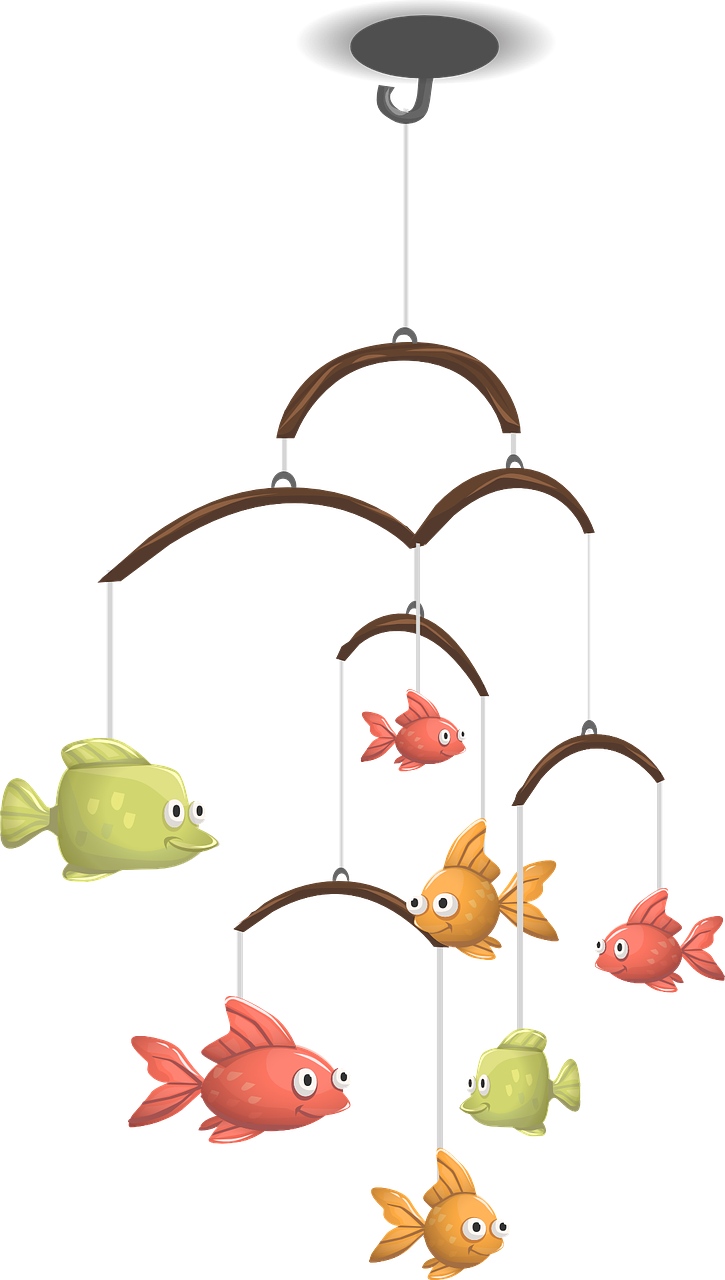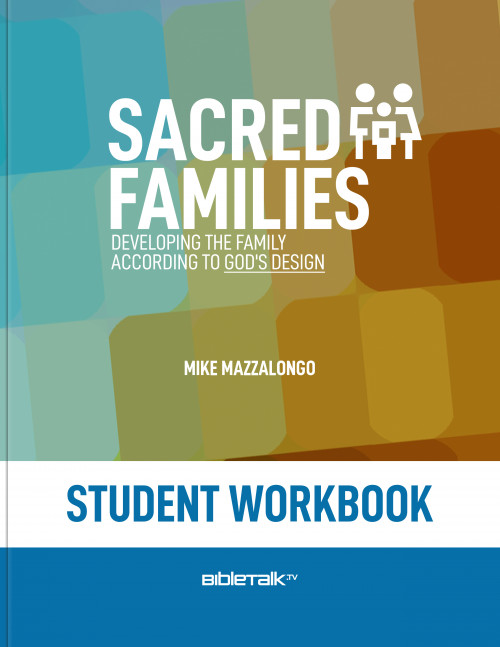Family Mobile: Seven Ways to Look at the Christian Home
Part 1

When I talk about Family Mobile, I am not talking about mobility as in a mobile home, or portability. I am talking about an art form as developed by people such as Alexander Calder, the American sculptor and artist who was credited with introducing the "mobile" as an artistic medium in the early 20th century. Originally trained as an engineer, Calder studied art in New York and later settled in Paris. He returned to the U.S. and worked primarily as a sculptor and produced many large outdoor pieces (one for the World's Fair in Montreal's Expo '67 entitled Man). What he was best known for, however, were his mobile creations which were made with various materials attached together with wires and hung to display, usually moved by the wind. His mobiles had beauty, balance, form and motion. Anyone could make them with an unending number of materials and styles, but they were always recognizable as mobiles.
In the book entitled What is a Family?, author Edith Schaeffer says that families are very much like these mobiles: connected yet different; counterbalanced so that to remove one element would upset the others; displaying a separate yet beautiful unit as a whole; and produced in endless varieties but always recognizable as a family.
In this chapter, therefore, we will look at the family as a living mobile and examine the different elements that can create beauty, balance and form in the sacred family. Here are some of the pieces you might want to use if you were creating your own "Sacred Family Mobile."
Elements in the Sacred Family Mobile
1. A Balanced Environment
The family is God's design for the producing and maturing of human beings and, like the creation itself, it needs to be balanced. For example, many years ago the Communist Chinese government began a program to kill off sparrows because they felt that these birds were eating too much of the rice crop. When they devastated the sparrow population in one area, the insects that had been eaten by these birds grew and totally devoured the rice anyways. This experience taught the government that creating a man-made unbalance in nature had consequences.
In the same way, God created balance in the family so it would be fruitful in honoring Him and enjoy His blessings. When we tamper with His balance in the family environment there are always negative results. The particular balance that God created in the family was a sense of oneness despite the gender and emotional differences between the partners in marriage. For example, He made woman to be beautiful and desirable to man and vice versa. That opposite genders attract is something God created in order to produce balance and oneness in their marital relationship.
After the fall of man through sin, God instituted roles within marriage in order to mitigate man's tendency towards sin. This order would serve to maintain the oneness and balance that would now be continually challenged by human weakness and sinfulness.
The balanced environment consists of one man and one woman committed to a lifetime relationship in a legal marriage. This is the godly standard as opposed to two men, or two women; or purposefully single parents; or one man and several women; or a man and woman living together without the commitment of a legal marriage. These arrangements are possible and becoming quite acceptable in our society but do not resemble the balanced environment originally conceived for marriage by God (Genesis 2:24).
This balanced environment also contains certain roles for men and women within marriage. Men as spiritual and moral leaders as well as protectors of their families. Women willingly offering their submission to their husbands and charged with the formation of the home and family.
Many debate or reject these roles in light of today's ideas about male and female roles, but what cannot be rejected or debated is that this is what the Bible describes as the roles of men and women in marriage. God has assigned these so that there can be peace and harmony within marriage and families. Considering the high rate of divorce among those who reject these "traditional" roles, we can assume that God has given us the best way to insure happy and peaceful relationships within marriage.
God's balanced environment also requires a commitment from both partners to the priority of family. Hillary Clinton (former U.S. Secretary of State) is fond of saying, "It takes a village to raise a child" and I think in a sense that she is correct that everyone should feel a responsibility for the well-being and discipline of a child. However, in the biblical scheme of things, the parents have the first and foremost responsibility for their children, and exercise this with the help of the village, not the other way around.
In today's society it seems that parents have given over their parenting duties to the village and bailed out. People get married, have children, and think that the home and children will care for themselves while they pursue careers, hobbies and other interests. There are many couples who do not realize that marriage makes your partner the priority over every other person in the world, and children make your home and family a priority over every other organization, activity or pursuit in your life. When both partners are committed first and foremost to one another and their family, they have then created the safe structure necessary to build a real "home" no matter what kind of house or apartment they live in.
The first element in our sacred family mobile, therefore, is a balanced environment created by a focused commitment to build a home and family according to God's design, not what the present social fad for family happens to be.
Another element in the family mobile...
2. A Sense of Home
Now, "home" is more than just a place to sleep or stay warm. Home is where your memories live, it is where you are always welcome and the place you care for those you love. The point I want to stress about home, however, is that somebody needs to create the home, it does not just happen by itself. For example, our house has a stairway leading from the dinning room to the bedrooms upstairs and there is a wall on one side of that stairwell. My niece, who is an interior designer, would have collected many pieces of art and decoration to make that wall colorful and pleasing to the eye. In her opinion this would help decorate our house. Instead, that wall is covered with family pictures from different periods (the wedding pictures of our four children, graduation photos from the military and college, a great picture of our son, William, surfing, etc.). All of these images are housed in mismatched frames with various colors that don't get high marks for decoration but say that this house is a home to this family. Every one of those photos captures something we as a family did together. They describe the culmination of hard work, cooperation, discipline and moments of joy that were shared at some time or another in the past. Although none of the things in the pictures happened in the house we now live in where the pictures are hung, the family that meets there is home to one another.
In my lifetime I have moved over 40 times (hard to believe, but true), so no single house represents home to me or to our family. However, the shared experiences that Lise and I have had with our children and the things we have purposefully done to cultivate our sense of family, these are home to us wherever we live.
3. A Place for Creativity
We are made in the image of a creative Divine Being. It is no wonder then that humans are creative. For this reason, the family should be a place where creativity is nurtured and given an opportunity to be expressed. Every member should be encouraged to act upon constructive creative impulses, even if the first attempts may be amateurish and limited.
Creativity is not only about music or art, but satisfying one's curiosity and sense of exploration. For example, I remember as a little boy I wanted to build my own hockey game. My mother could have said, "too complicated" or, "we cannot get all the springs and levers needed to work the players, etc." Instead, she allowed me to find wood and glue to stick on the plastic hockey figures as well as markers and grey paint for the ice. In the end the final product was just a flat piece of wood with plastic figures glued on and grey paint unevenly applied. My creation did not really function as a playable hockey game, but for two days I remember the creative rush of cutting, painting and putting together in material form what had only been an idea in my mind.
Some may think it requires money or personal artistic abilities to provide a home that encourages creativity. Of course, this can be helpful, but what is needed most of all is the permission to allow the creative impulse to be born and expressed freely without all the soul-killing reasons why something will not work or why an idea is impractical. There is plenty of time to evaluate things and analyze ideas without suffocating the creative impulses given to us by God as a gift.
One of the most valuable features of the sacred family is its ability to produce ideas that ultimately honor God and bless others with beauty and service.
4. A Training Ground for Relationships
Someone said to Lise when we were first married that we should have our children close together so that they would all be friends. We had four kids in five years and it seems that all they did was fight for the first 15 of these years. One unfortunate example of this was when our eldest son, Paul, tied his younger sister to a pole in the basement (they were playing cowboys and Indians), turned out the lights and left her there in the dark with the basement door closed. Needless to say Lise was not amused when she came to Julia's rescue after hearing her cries. Julia, however, was the first to jump in and defend her brother when bigger boys were trying to hurt and bully him.
A family is a training center for all kinds of relationships. It is where we first learn to say, "I am sorry; Congratulations; Happy Birthday; Let's surprise Dad; I will lend you this if you share that." A sacred family is also the place where children learn that other people are not machines or higher forms of monkeys, but are actually made in the image of God, and this is why we treat them the way we do. Family is where we teach and learn that the solution to a difference of opinion, an insult, selfishness, a lie or a fight is not leaving home to find another family.
Training within families about relationships should teach us about forgiveness, perseverance, discussion, compromise and patience. As far as the mobile illustration goes, training in relationships is the wire that holds all of the elements together.
Today, Paul and Julia talk on the phone several times a week and each considers their three siblings their best friends.
Schaeffer, E. (1975) What is a Family? Grand Rapids, MI: Baker Book House Company.



